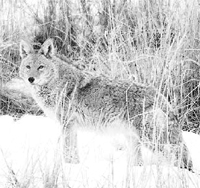Coyotes Settle in at Fermilab

Photo by Robert McKemie
He is sly, cunning, swift, smart, but more often than not undone through his own devices. She is called sun dog, laughing dog, barking dog or little wolf. The ambiguity surrounding coyotes extends to the pronunciation of their name: you say kai-ó-te, I say kaí-oat. The word comes from the Aztec word coyotl, which suggests that a three-syllable name might be more authentic.
Few animals have elicited more interest and emotion than the coyote, whose reputation in Native American lore as a sly and treacherous survivor holds up well against the animal's natural history since European settlement. Campaigns to eradicate the coyote have met with little success. If anything, the coyote has extended its range -- ironically with the help of settlers, who were remarkably successful at driving out the coyote's cousin and erstwhile competitor, the wolf.
Employees and visitors at Fermilab often see coyotes in the early morning, gracefully loping across the fields. Jim Kalina, of Roads and Grounds, estimates that as many as 15 animals currently reside at the Lab, including triplet pups born here in 1996. The young animals typically disperse after a year or two, seeking out their own home ranges. Although the animals at Fermilab are generally in good health, some individuals have contracted mange, a common canine disease.
Coyotes are remarkably adaptable. They tolerate our presence, and even capitalize on some of the fruits of civilization. They gladly raid garbage pails or take advantage of cast-off tidbits, and they demonstrate an uncanny ability to avoid humans in our more predatory moods. On the other hand, they present no real threat. A recent survey of literature from the last 30 years produced reports of only 16 attacks on humans in North America, none of which were fatal.
Reading the signs
The indirect impact of coyotes on human endeavors is more controversial. Depradation by coyotes on livestock, especially sheep, is often due to rogues killing weak and vulnerable animals. For the most part, coyotes are opportunists who prefer smaller, more tractable game. Lynda Randa, an ecologist from Northern Illinois University, conducted a study from 1993 to 1995 at Fermilab and found that over 90 percent of coyote droppings contained small mammal remains. About 80 percent of those were field mice and rabbits. The remainder were squirrels, pheasant, deer (probably scavenged), invertebrates and plant material.
Coyotes tend to be nocturnal, although if not harassed by humans, they will hunt during the daylight. They prefer a mixture of wooded and open land, a preference nicely fulfilled by human-created landscapes. Before 1900, there were probably few coyotes east of the Mississippi River, but they quickly settled the new farmland after the eradication of wolves.
The Illinois Department of Natural Resources reports that the state's coyote population has remained stable for the last seven years. Local naturalists and biologists agree that the state-wide population is steady, but the urban and suburban population seems to be increasing. Animal control agents destroy one to three coyotes each year at O'Hare and Midway airports to protect aircraft from collisions, and the number of complaints from suburban neighborhoods has increased.
In Native American cosmogony, coyotes are portrayed as creators, "singing humans into being" or placing the North Star in the heavens. They are said to bring rain (or not), and have the ability to change the appearance of things. Whatever the coyotes' role in determining the fabric of the world, we will likely continue to share it with them in a grudging, sometimes admiring coexistence.


